https://www.facebook.com/permalink.php?story_fbid=946923118684200&id=163322863710900
(objavljeno 15.09.2015. na Facebook stranici Evropske unije u Bosni i Hercegovini)
Blog containing a database of articles, reports, blogger's notes and photos of Bosnia and Herzegovina and Balkans region. The compilation and material was created by Aleksandra Miletić-Šantić, a lawyer, social scientist, human rights activist, journalist and interpreter.
https://www.facebook.com/permalink.php?story_fbid=946923118684200&id=163322863710900
(objavljeno 15.09.2015. na Facebook stranici Evropske unije u Bosni i Hercegovini)
https://amp.theguardian.com/world/2002/apr/22/warcrimes.comment?fbclid=IwAR2n8L3llMx7R7B8q0rKYq4YLJUEaWfYIhUpwviBqowNMXa9x8UEv3GxQHk
The Srebrenica report reveals the Pentagon's role in a dirty war
The official Dutch inquiry into the 1995 Srebrenica massacre, released last week, contains one of the most sensational reports on western intelligence ever published. Officials have been staggered by its findings and the Dutch government has resigned. One of its many volumes is devoted to clandestine activities during the Bosnian war of the early 1990s. For five years, Professor Cees Wiebes of Amsterdam University has had unrestricted access to Dutch intelligence files and has stalked the corridors of secret service headquarters in western capitals, as well as in Bosnia, asking questions.
His findings are set out in
"Intelligence and the war in Bosnia, 1992-1995". It includes remarkable
material on covert op
erations, signals interception, human agents and
double-crossing by dozens of agencies in one of dirtiest wars of the new
world disorder. Now we have the full story of the secret alliance
between the Pentagon and radical Islamist groups from the Middle East
designed to assist the Bosnian Muslims - some of the same groups that
the Pentagon is now fighting in "the war against terrorism". Pentagon
operations in Bosnia have delivered their own "blowback".
In the 1980s Washington's secret services had assisted Saddam Hussein in his war against Iran. Then, in 1990, the US fought him in the Gulf. In both Afghanistan and the Gulf, the Pentagon had incurred debts to Islamist groups and their Middle Eastern sponsors. By 1993 these groups, many supported by Iran and Saudi Arabia, were anxious to help Bosnian Muslims fighting in the former Yugoslavia and called in their debts with the Americans. Bill Clinton and the Pentagon were keen to be seen as creditworthy and repaid in the form of an Iran-Contra style operation - in flagrant violation of the UN security council arms embargo against all combatants in the former Yugoslavia.
The result was a vast secret conduit of weapons smuggling though Croatia. This was arranged by the clandestine agencies of the US, Turkey and Iran, together with a range of radical Islamist groups, including Afghan mojahedin and the pro-Iranian Hizbullah. Wiebes reveals that the British intelligence services obtained documents early on in the Bosnian war proving that Iran was making direct deliveries.
Arms purchased by Iran and Turkey with the financial backing of Saudi Arabia made their way by night from the Middle East. Initially aircraft from Iran Air were used, but as the volume increased they were joined by a mysterious fleet of black C-130 Hercules aircraft. The report stresses that the US was "very closely involved" in the airlift. Mojahedin fighters were also flown in, but they were reserved as shock troops for especially hazardous operations.Light weapons are the familiar currency of secret services seeking to influence such conflicts. The volume of weapons flown into Croatia was enormous, partly because of a steep Croatian "transit tax". Croatian forces creamed off between 20% and 50% of the arms. The report stresses that this entire trade was clearly illicit. The Croats themselves also obtained massive quantities of illegal weapons from Germany, Belgium and Argentina - again in contravention of the UN arms embargo. The German secret services were fully aware of the trade.
Rather than the CIA, the Pentagon's own secret service was the hidden force behind these operations. The UN protection force, UNPROFOR, was dependent on its troop-contributing nations for intelligence, and above all on the sophisticated monitoring capabilities of the US to police the arms embargo. This gave the Pentagon the ability to manipulate the embargo at will: ensuring that American Awacs aircraft covered crucial areas and were able to turn a blind eye to the frequent nightime comings and goings at Tuzla.
Weapons flown in during the spring of 1995 were to turn up only a fortnight later in the besieged and demilitarised enclave at Srebrenica. When these shipments were noticed, Americans pressured UNPROFOR to rewrite reports, and when Norwegian officials protested about the flights, they were reportedly threatened into silence.
Both the CIA and British SIS had a more sophisticated perspective on the conflict than the Pentagon, insisting that no side had clean hands and arguing for caution. James Woolsey, director of the CIA until May 1995, had increasingly found himself out of step with the Clinton White House over his reluctance to develop close relations with the Islamists. The sentiments were reciprocated. In the spring of 1995, when the CIA sent its first head of station to Sarajevo to liaise with Bosnia's security authorities, the Bosnians tipped off Iranian intelligence. The CIA learned that the Iranians had targeted him for liquidation and quickly withdrew him.
Iranian and Afghan veterans' training camps had also been identified in Bosnia. Later, in the Dayton Accords of November 1995, the stipulation appeared that all foreign forces be withdrawn. This was a deliberate attempt to cleanse Bosnia of Iranian-run training camps. The CIA's main opponents in Bosnia were now the mojahedin fighters and their Iranian trainers - whom the Pentagon had been helping to supply months earlier.
Meanwhile, the secret services of Ukraine, Greece and Israel were busy arming the Bosnian Serbs. Mossad was especially active and concluded a deal with the Bosnian Serbs at Pale involving a substantial supply of artillery shells and mortar bombs. In return they secured safe passage for the Jewish population out of the besieged town of Sarajevo. Subsequently, the remaining population was perplexed to find that unexploded mortar bombs landing in Sarajevo sometimes had Hebrew markings.
The broader lessons of the intelligence report on Srebrenica are clear. Those who were able to deploy intelligence power, including the Americans and their enemies, the Bosnian Serbs, were both able to get their way. Conversely, the UN and the Dutch government were "deprived of the means and capacity for obtaining intelligence" for the Srebrenica deployment, helping to explain why they blundered in, and contributed to the terrible events there.
Secret intelligence techniques can be war-winning and life-saving. But they are not being properly applied. How the UN can have good intelligence in the context of multinational peace operations is a vexing question. Removing light weapons from a conflict can be crucial to drawing it down. But the secret services of some states - including Israel and Iran - continue to be a major source of covert supply, pouring petrol on the flames of already bitter conflicts.
· Richard J Aldrich is Professor of Politics at the University of Nottingham. His 'The Hidden Hand: Britain, America and Cold War Secret Intelligence' is published in paperback by John Murray in August.
https://engineering.fb.com/2015/06/02/core-data/recommending-items-to-more-than-a-billion-people/

The growth of data on the web has made it harder to employ many machine learning algorithms on the full data sets. For personalization problems in particular, where data sampling is often not an option, innovating on distributed algorithm design is necessary to allow us to scale to these constantly growing data sets.
Collaborative filtering (CF) is one of the important areas where this applies. CF is a recommender systems technique that helps people discover items that are most relevant to them. At Facebook, this might include pages, groups, events, games, and more. CF is based on the idea that the best recommendations come from people who have similar tastes. In other words, it uses historical item ratings of like-minded people to predict how someone would rate an item.
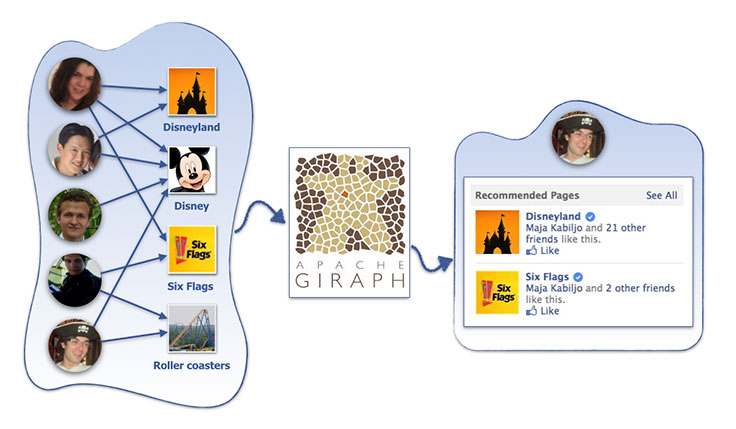
Facebook’s average data set for CF has 100 billion ratings, more than a billion users, and millions of items. In comparison, the well-known Netflix Prize recommender competition featured a large-scale industrial data set with 100 million ratings, 480,000 users, and 17,770 movies (items). There has been more development in the field since then, but still, the largest numbers we’ve read about are at least two orders of magnitude smaller than what we’re dealing with.
A challenge we faced is to design a distributed algorithm that is going to scale to these massive data sets, and how to overcome issues that arose because of certain properties of our data (like skewed item degree distribution, or implicit engagement signals instead of ratings).
As we’ll discuss below, approaches used in existing solutions would not efficiently handle our data sizes. Simply put, we needed a new solution. We’ve written before about Apache Giraph, a powerful platform for distributed iterative and graph processing, and the work we put into making it scale to our needs. We’ve also written about one of the applications we developed on top of it about graph partitioning. Giraph works extremely well on massive data sets, it is easily extensible, and we have a lot of experience in developing highly performant applications on top of it. Therefore, Giraph was our obvious choice for this problem.
A common approach to CF is through matrix factorization, in which we look at the problem as having a set of users and a set of items, and a very sparse matrix that represents known user-to-item ratings. We want to predict missing values in this matrix. In order to do this, we represent each user and each item as a vector of latent features, such that dot products of these vectors closely match known user-to-item ratings. The expectation is that unknown user-to-item ratings can be approximated by dot products of corresponding feature vectors, as well. The simplest form of objective function, which we want to minimize, is:

Here, r are known user-to-item ratings, and x and y are the user and item feature vectors that we are trying to find. As there are many free parameters, we need the regularization part to prevent overfitting and numerical problems, with gamma being the regularization factor.
It is not currently feasible to find the optimal solution of the above formula in a reasonable time, but there are iterative approaches that start from random feature vectors and gradually improve the solution. After some number of iterations, changes in feature vectors become very small, and convergence is reached. There are two commonly used iterative approaches.
Stochastic gradient descent (SGD) optimization was successfully practiced in many other problems. The algorithm loops through all ratings in the training data in a random order, and for each known rating r, it makes a prediction r* (based on the dot product of vectors x and y) and computes prediction error e. Then we modify x and y by moving them in the opposite direction of the gradient, yielding certain update formulas for each of the features of x and y.
Alternating least square (ALS) is another method used with nonlinear regression models, when there are two dependent variables (in our case, vectors x and y). The algorithm fixes one of the parameters (user vectors x), while optimally solving for the other (item vectors y) by minimizing the quadratic form. The algorithm alternates between fixing user vectors and updating item vectors, and fixing item vectors and updating user vectors, until the convergence criteria are satisfied.
In order to efficiently solve the above formula in a distributed way, we first looked at how systems that are similar in design to Giraph do it (using message passing instead of map/reduce). The standard approach corresponds to having both users and items as vertices of a graph, with edges representing known ratings. An iteration of SGD/ALS would then send user and/or item feature vectors across all the edges of the graph and do local updates.
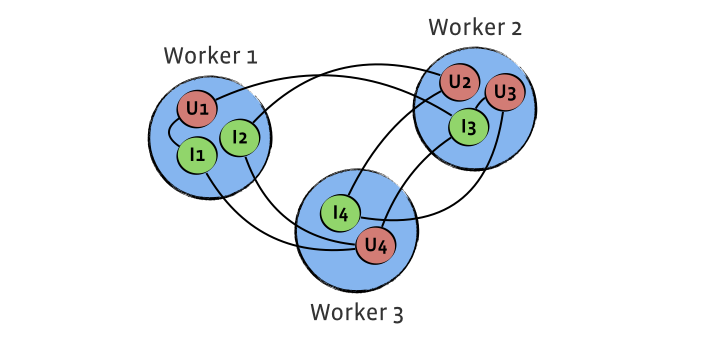
There are a few problems with this solution:
The main problem is sending all updates within each iteration, so we needed a new technique of combining these updates and sending less data. First we tried to leverage aggregators and use them to distribute item data, but none of the formulas we tried for combining partial updates on the item feature vectors worked well.
We finally came up with an approach that required us to extend Giraph framework with worker-to-worker messaging. Users are still presented as the vertices of the graph, but items are partitioned in #Workers disjoint parts, with each of these parts stored in global data of one of the workers. We put all workers in a circle, and rotate the items in clockwise direction after each superstep, by sending worker-to-worker messages containing items from each worker to the next worker in the line.
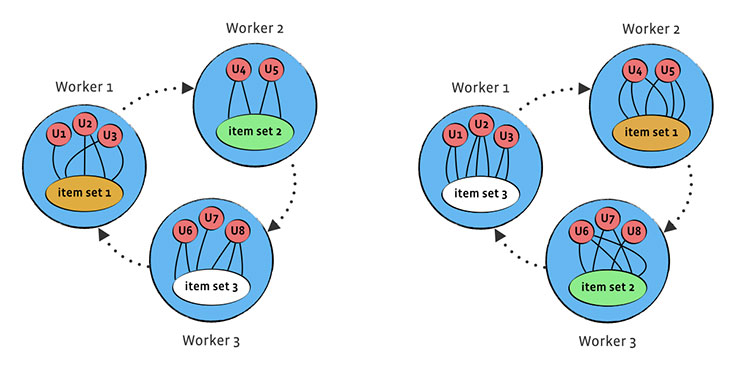
This way, in each superstep, we process part of the worker’s user ratings for the items that are currently on the worker, and therefore process all ratings after #Workers supersteps. Let’s analyze the issues the previous solutions had:
The computation with ALS is trickier than with SGD, because in order to update a user/item, we need all its item/user feature vectors. The way updates in ALS actually go is that we are solving a matrix equation of type A * X = B, where A is #Features x #Features matrix and B is 1 x #Features vector, and A and B are calculated based on user/item feature vectors forming all known ratings for item/user. So when updating items, instead of rotating just their feature vectors, we can rotate A and B, update them during each of #Workers supersteps and calculate new feature vectors in the end. This increases the amount of network traffic to #Items * #Features2 * #Workers. Depending on proportions between all the data dimensions, for some items this is better than the standard approach, and for some it isn’t.
This is why a blend of our rotational approach and the standard approach gives the superior solution. By looking at item with some degree, in the standard approach the amount of network traffic associated with it is degree * #Features, and with our rotational approach, it’s #Workers * #Features2. We’ll still update items in which degree < #Workers * #Features using the standard approach, and we’ll use our rotational approach for all larger-degree items, and therefore significantly improve performance. For example, for 100 double features and 50 workers, the item degree limit for choosing an approach is around 5,000.
To solve the matrix equation A * X = B we need to find the inverse A-1, for which we use open source library JBLAS, which had the most efficient implementation for the matrix inverse.
As SGD and ALS share the same optimization formula, it is also possible to combine these algorithms. ALS is computationally more complex than SGD, and we included an option to do a combination of some number of iterations of SGD, followed by a single iteration of ALS. For some data sets, this was shown to help in the offline metrics (e.g., root mean squared error or mean average rank).
We were experiencing numerical issues with large-degree items. There are several ways of bypassing this problem (ignoring these items or sample them), but we were using regularization based on the item and user degrees. That keeps the values for user and item vectors in a certain numerical range.
In order to measure the quality of recommendations, before running an actual A/B test, we can use a sample of the existing data to compute some offline metrics about how different our estimations are from the actual user preferences. Both of the above algorithms have a lot of hyperparameters to tune via cross-validation in order to get the best recommendations, and we provide other options like adding user and item biases.
The input ratings can be split in two data sets (train and test) explicitly. This can be very useful in cases in which testing data is composed of all user actions in the time interval after all training instances. Otherwise, to construct the test data, we randomly selected T=1 items per user, and keep them apart from training.
During the algorithm, for a certain percent of users we rank all unrated items (i.e., items that are not in the training set) and observe where training and testing items are in the ranked list of recommendations. Then we can evaluate the following metrics: mean average rank (the position in the ranked list, averaged over all test items), precision at positions 1/10/100, mean of the average precision across all test items (MAP), etc. Additionally we compute root mean squared error (RMSE), which amplifies the contributions of the absolute errors between the predictions and the true values. To help monitor convergence and quality of results, after each iteration we are printing all these metrics.
On a sample data set with 35 billion weighted training ratings and 0.2 billion testing ratings, the following figure shows how RMSE reduces on training and testing sets for #Features=8 or #Features=128, where other parameters are fixed.

In order to get the actual recommendations for all users, we need to find items with highest predicted ratings for each user. When dealing with the huge data sets, checking the dot product for each (user, item) pair becomes unfeasible, even if we distribute the problem to more workers. We needed a faster way to find the top K recommendations for each user, or a good approximation of it.
One possible solution is to use a ball tree data structure to hold our item vectors. A ball tree is a binary tree where leafs contain some subset of item vectors, and each inner node defines a ball that surrounds all vectors within its subtree. Using formulas for the upper bound on the dot product for the query vector and any vector within the ball, we can do greedy tree traversal, going first to the more promising branch, and prune subtrees that can’t contain the solution better than what we have already found. This approach showed to be 10-100x faster than looking into each pair, making search for recommendations on our data sets finish in reasonable time. We also added an option to allow for specified error when looking for top recommendations to speed up calculations even more.
Another way the problem can be approximately solved is by clustering items based on the item feature vectors — which reduces the problem to finding top cluster recommendations and then extracting the actual items based on these top clusters. This approach speeds up the computation, while slightly degrading the quality of recommendations based on the experimental results. On the other hand, the items in a cluster are similar, and we can get a diverse set of recommendations by taking a limited number of the items from each cluster. Note that we also have k-means clustering implementation on top of Giraph, and incorporating this step in the calculation was very easy.
Spark MLlib is a very popular machine-learning library that contains one of the leading open source implementations in this domain. In July 2014, the Databricks team published performance numbers of their ALS implementation on Spark. Experiments were conducted on scaled copies of the Amazon reviews data set, which originally contained 35 million ratings and ran for five iterations.
In the following graph, we compared our rotational hybrid approach (which we implemented in Giraph) with the standard approach (implemented in Spark MLlib, including some additional optimizations, like sending a feature vector at most once to a machine), on the same data set. Due to hardware differences (we had about twice the processing power per machine), in order to make a fair comparison we were looking at total CPU minutes. Rotational hybrid solution was about 10x faster.
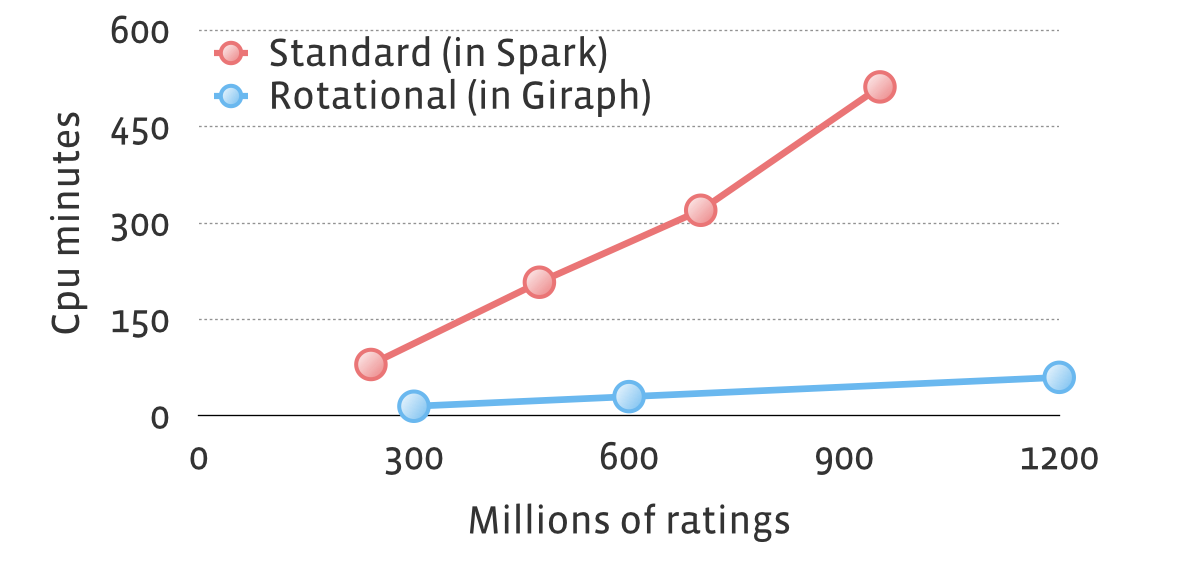
Additionally, the largest data set on which experiments were conducted with standard approach had 3.5 billion ratings. With rotational hybrid approach, we can easily handle more than 100 billion ratings. Note that quality of results is the same for both, and all performance and scalability gains come from different data layout and decreased network traffic.
We used this algorithm for multiple applications at Facebook, e.g. for recommending pages you might like or groups you should join. As already mentioned, our data sets are composed of more than 1 billion users and usually tens of millions of items. There are actually many more pages or groups, but we limit ourselves to items that pass a certain quality threshold — where the simplest version is to have the item degree greater than 100. (Fun side note: On the other side, we have some very large-degree pages — the “Facebook for Every Phone” page is actually liked by almost half of Facebook’s current monthly active users.)
Our first iterations included page likes/group joins as positive signals. The negative signals on Facebook are not as common (negative signals include unliking a page or leaving a group after some time). Also this may not actually mean that a user has negative feedback for that item; instead, he or she might have lost interest in the topic or in receiving updates. In order to get good recommendations, there is a significant need for adding negative items from the unrated pairs in the collection. Previous approaches include randomly picking negative training sample from unrated items (leading to a biased, non-optimal solution) or treating all unknown ratings as negative, which tremendously increases complexity of the algorithm. Here, we implemented adding random negative ratings by taking into account the user and item degrees (adding negative ratings proportional to the user degree based on the item degree distribution), and weighing negative ratings less than positive ones, as we failed to learn a good model with uniform random sampling approach.
On the other hand, we have implicit feedback from users (whether the user is actively viewing the page, liking, or commenting on the posts in the group). We also implemented a well-known ALS-based algorithm for implicit feedback data sets. Instead of trying to model the matrix of ratings directly, this approach treats the data as a combination of binary preferences and confidence values. The ratings are then related to the level of confidence in observed user preferences, rather than explicit ratings given to items.
After running the matrix factorization algorithm, we have another Giraph job of actually computing top recommendations for all users.
The following code just shows how easy it is to use our framework, tune parameters, and plug in different data sets:
CFTrain(
ratings=CFRatings(table='cf_ratings'),
feature_vectors=CFVectors(table='cf_feature_vectors'),
features_size=128,
iterations=100,
regularization_factor=0.02,
num_workers=5,
)
CFRecommend(
ratings=CFRatings(table='cf_ratings'),
feature_vectors=CFVectors(table='cf_feature_vectors'),
recommendations=CFRecommendations(table='cf_recommendations'),
num_recommendations=50,
num_workers=10,
)
Furthermore, one can simply implement other objective functions (such as rank optimizations or neighboring models) by extending SGD or ALS computation.
Recommendation systems are emerging as important tools for predicting user preferences. Our framework for matrix factorization and computing top user recommendations is able to efficiently handle Facebook’s massive data sets with 100 billion ratings. It is easy to use and extend with other approaches.
We are thinking about many improvements and algorithms, including:
We are actively working on recommendations and many other applications on top of Giraph, so stay tuned for more exciting features and development in this field.
Thanks to Dionysios Logothetis, Avery Ching, Sambavi Muthukrishnan and Sergey Edunov from the Giraph team who made this work possible and helped write this story, and Liang Xiong and Bradley Green for early experimentation and all feedback and insights.
https://engineering.fb.com/2017/03/27/ml-applications/evaluating-boosted-decision-trees-for-billions-of-users/
Facebook uses machine learning and ranking models to deliver the best experiences across many different parts of the app, such as which notifications to send, which stories you see in News Feed, or which recommendations you get for Pages you might want to follow. To surface the most relevant content, it’s important to have high-quality machine learning models. We look at a number of real-time signals to determine optimal ranking; for example, in the notifications filtering use case, we look at whether someone has already clicked on similar notifications or how many likes the story corresponding to a notification has gotten. Because we perform this every time a new notification is generated, we want to return the decision for sending notifications as quickly as possible.
More complex models can help improve the precision of our predictions and show more relevant content, but the trade-off is that they require more CPU cycles and can take longer to return results. Given these constraints, we can’t always evaluate all possible candidates. However, by improving the efficiency of the model, we can evaluate more inventory in the same time frame and with the same computing resources.
In this post, we compare different implementations of a type of predictive model called a gradient-boosted decision tree (GBDT) and describe multiple improvements in C++ that resulted in more efficient evaluations.
Decision trees are commonly used as a predictive model, mapping observations about an item to conclusions about the item’s target value. It is one of the most common predictive modeling approaches used in machine learning, data analysis, and statistics due to its non-linearity and fast evaluation. In these tree structures, leaves represent class labels and branches represent conjunctions of features that lead to those class labels.
Decision trees are very powerful, but a small change in the training data can produce a big change in the tree. This is remedied by the use of a technique called gradient boosting. Namely, the training examples that were misclassified have their weights boosted, and a new tree is formed. This procedure is then repeated consecutively for the new trees. The final score is taken as a weighted sum of the scores of the individual leaves from all trees.
Models are normally updated infrequently, and training complex models can take hours. At Facebook’s scale, however, we want to update the models more often and run them on the order of milliseconds. Many backend services at Facebook are written in C++, so we leveraged some of the properties of this language and made improvements that resulted in a more efficient model that takes fewer CPU cycles to evaluate.
In the next figure we have a simple decision tree with the following features:
At different nodes, we check the values of the above features and traverse the tree to get the probability of clicking on a notification.
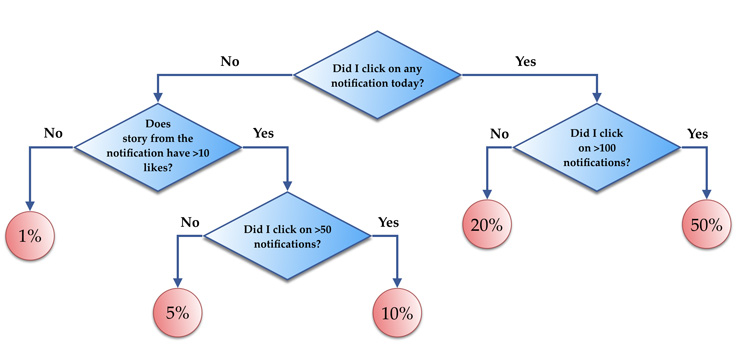
The naive implementation of the decision tree model is a simple binary tree with pointers. However, this is not very efficient due to the fact that the nodes do not need to be stored consecutively in the memory.
On the other hand, decision trees are usually full binary trees (a binary tree in which each node has exactly zero or two children) and can be stored compactly using vectors. No space is required for the pointer; instead, the parent and children of each node can be found by arithmetic on array indices. We will use this implementation for comparison in the experimentation section.
Each binary tree can be represented as a complex ternary expression, which can be compiled and linked to a dynamic library (DLL) that can be directly used in the service. Note that we can add or update the decision tree model in real time without restarting the service.
We can also take advantage of LIKELY/UNLIKELY annotations in C++. They are directions for the compiler to emit instructions that will cause branch prediction to favor the “likely” side of a jump instruction. If the prediction is correct, it means that the jump instruction will take zero CPU cycles. We can compute branch predictions based on the real samples from the ranking in batches or from the offline analysis, as the distributions from training and evaluation sets should not change much.
The following code represents an implementation of the above simiple decision tree:
int tree(double* F) {
return LIKELY(F[0] < 1)
? (UNLIKELY(F[1] > 10) ? (F[2] > 50 ? 0.1 : 0.05) : 0.01)
: (F[2] > 100 ? 0.5 : 0.2);
}
Model range evaluation
In a typical ranking setup, we need to evaluate the same trained model on multiple instances of feature vectors. For example, we need to rank ~1,000 different potential candidates for a given person, and pick only the most relevant ones.
One approach is to iterate through all candidates and rank them one by one. Typically, the model and all candidates cannot fit together into the CPU instruction cache. Motivated by the boosted training, we can actually split the model into ranges of trees (the first N trees, then the next N trees, and so on), so that each range will be small enough to fit the cache memory. Then we can flip the evaluation order: Instead of evaluating all trees on a sample, we will evaluate all samples on each range. This way we can fit the whole tree set in the CPU cache together with all feature vectors, and in the next iteration just replace the tree set. This reduces the number of cache misses and uses block reads/writes instead of RAM.
Furthermore, we often have multiple models that we need to evaluate on the same feature vectors; for example, the probability of the user clicking, liking, or commenting on the notification story. This helps keep all feature vectors in the CPU cache and evaluating models one by one.
Another trade-off that we can make is to rank all candidates for the first N trees and then, due to the nature of boosted algorithms, discard the lowest-ranked candidates. This can improve the latency, but it comes with a slight drop in accuracy.
Common features
Sometimes features are common across all feature vectors. In the above example for a certain person, we need to rank all candidate notifications. The feature vectors [F[0], F[1], F[2]] described above can be something like this:
[0, 2, 100]
[0, 0, 100]
[0, 1, 100]
[0, 1, 100]
It’s easily noticeable that the features F[0] and F[2] are the same for candidates. We can significantly reduce the decision tree size by just focusing on the value F[1], and thus improve the evaluation time.
Categorical features
Most ML algorithms use binary trees, and this can be extended to k-ary trees. On the other hand, some of the features are not actually comparable and are called categorical features. For example, if country is a feature, one cannot say whether the value is less than or equal to “US” (or a corresponding enum value). If the tree is deep enough, this comparison can be achieved using multiple levels, but here we implemented the possibility for checking whether the current feature belongs to a set of values.
The learning method is not changed much — we still try to find the
best subset to split on, and the evaluation is very fast. Based on the
size of the set, we use the in_set C++ implementation or just concatenate if conditions. This reduces the model size and helps in convergence as well.
We trained a boosted decision tree model for predicting the probability of clicking a notification using 256 trees, where each of the trees contains 32 leaves. Next, we compared the CPU usage for feature vector evaluations, where each batch was ranking 1,000 candidates on average. The batch size value N was tuned to be optimal based on the machine L1/L2 cache sizes. We saw the following performance improvements over the flat tree implementation:
The performance improvements were similar for different algorithm parameters (128 or 512 trees, 16 or 64 leaves).
These improvements in CPU usage and resulting speedups allowed us to increase the number of examples we rank or increase the model size using the same amount of resources. This approach has been applied to several ranking models at Facebook, including notifications filtering, feed ranking, and suggestions for people and Pages to follow. Our machine learning platforms are constantly evolving; more precise models combined with more efficient model evaluations will allow us to continually improve our ranking systems to serve the best personalized experiences for billions of people.
https://www.linkedin.com/in/aleksandar-ilic-a1650215
- Privacy lead for cross account data sharing
- Leading
Identity Platform team of 50+ people for the Facebook Family of Apps
(Facebook, Instagram, WhatsApp, Oculus) with product applications in
Growth, Ads, Analytics, Integrity.
- Built notifications system team at Facebook for targeting and optimizing notifications sending via push, SMS and email
-
Senior researcher in the spectral and chemical graph theory,
combinatorics, algorithms and social networks (over 100 publications
https://scholar.google.com/citations?user=qnL0jnwAAAAJ&hl=en)
Experience


- 10 years 2 months
Palo Alto, CA
- Company privacy lead for cross app data sharing
- Leading
Identity Platform team of 50+ people for the Facebook Family of Apps
with applications on Growth, Ads, Accounting, Integrity.
- Previously
team lead (20+ people) on Notifications system used by all teams at
Facebook for targeting and optimizing notifications sending via push,
SMS, email
- Previously part of Facebook growth team and responsible for adding 20+ million of incremental MAP and DAP users
- Designed multiple large…

- 3 years 2 months
Team leader for classification and indexing.
Working on:
hot list aggregation and distribution, web pages category
classification, topics summary generation, user clustering.

- 3 years 1 month
Courses: Parallel and concurent programming, Introduction to informatics, Design and analysis of
algorithms, Introduction to graph theory and combinatorics, Discrete structures

- 1 year 1 month
Working on Information Extraction System and Semantic Search

-

-
http://www.glassrpske.com/lat/novosti/vijesti_dana/Avaz-trazi-50-miliona-evra-odstete/30211?fbclid=IwAR3QSSj58Ss-bcOiUnUPNcLaaZnkn_EtBP4gx4I6NnTXQNf40NB89DXM82g
SARAJEVO - Najveći izdavač u BiH "Avaz" najavio je u petak tužbu protiv OHR-a uz odštetni zahtjev od 50 miliona evra poslije razotkrivanja, kako tvrde, montiranih šema u kojima se politički i vjerski vrh bošnjačke vlasti kao i neki biznismeni u FBiH kvalifikuju kao kriminalna mreža, prenose agencije.
- Zbog nedopustivog i ničim argumentovanog pokušaja rušenja poslovnog kredibiliteta kompanije, "Avaz" će podnijeti krivičnu prijavu protiv zamjenika visokog predstavnika u BiH američkog diplomate Rafija Gregorijana i nepoznatog službenika OHR-a koji se zove Erik i označen je kao autor sporne šeme - navodi se u saopštenju.
Njih dvojica su, smatraju u sarajevskoj medijskoj kući, na "kriminalan način teško zloupotrijebili svoje funkcije i mandat OHR-a".
Dodaju da će za ovaj sudski spor kompanija "Avaz" angažovati referentne advokatske kancelarije u Vašingtonu i u Evropi.
Nedjeljnik "Global", koji je izdanje "Avaza", objavio je u posljednjem broju šeme, koje su navodno napravljene u OHR-u, a kojima se prikazuje dio političko-kriminalne mreže u Federaciji BiH.
Kao vođe mreže označeni su reis Mustafa Cerić, Hasan Čengić, Fahrudin Radončić, Bakir Izetbegović, Alija Delimustafića, Bakir Alispahić i Senad Šahinpašić Šaja.
Portparol OHR-a Ljiljana Radetić izjavila je "Glasu Srpske" da su "magazin 'Global' od 29. oktobra i dnevne novine 'Avaz' od 30. oktobra objavili priče koje su zasnovali na papirima koje su javno povezali sa Kancelarijom visokog predstavnika".
- Ono što su objavili izgleda kao grafički prikaz izvještavanja iz javnih izvora kroz nekoliko posljednjih godina. Visoki predstavnik duboko i iskreno žali zbog bilo kakve neugodnosti ili neprijatnosti izazvane objavljivanjem ovih članaka - kaže Radetićeva.
objavio Žurnal, 2.10.2019. (novinar Avdo Avdić)
https://zurnal.info/clanak/konakovicu-prebacili-325-hiljada-maraka-za-dodjelu-grantova-/22434?fbclid=IwAR0-hnt6UdRzJtABzlU8EY9KvxdDmBAbdv_Cbm-Ok3MhHr6IXQpgcl-0GKw
Vlada Kantona Sarajevo prebacila je najmanje 325 hiljada maraka namjenskih sredstava na Kabinet predsjedavajućeg Skupštine KS koje je Elmedin Konaković kasnije, kao grantove, proizvoljno dodjeljivao uduženjima bliskim svojoj političkoj partiji.
Samo u septembru ove godine Vlada je izvršila "preraspodjelu" 95 hiljada maraka, dok je u avgustu Konakovićev kabinet "pojačan" sa 100 hiljada maraka.
U junu je vladaru Kantona Sarajevo prebačeno 80 hiljada maraka, dok je na martovskoj sjednici na Kabinet predsjedavajućeg Skupštine KS preraspoređeno 50 hiljada maraka. Tako su tim preraspodjelama, između ostalog, sredstva namijenjena za školovanje mladih policajaca završila na "razdjelu" predjedavajućeg Skupštine Kantona Sarajevo kako bi on taj novac mogao odobriti "neprofitnim organizacijama".
"Odobrava se preraspodjela sredstava u Budžetu Kantona Sarajevo za 2019. godinu u iznosu od 60 hiljada maraka i to: sa razdjela 17 Ministarstvo unutrašnjih poslova Kantona Sarajevo, glava 02, potrošačka jedinica 0001 - Uprava policije, sa ekonomskog koda - izdaci za školovanje na policijskoj akademiji, na razdjel 10 Skupštine KS, poslanici i parlamentarne grupe, glava 03, potrošačka jedinica 0001 - Kabinet predsjedavajućeg i zamjenika predsjedavajućeg Skupštine KS na ekonomski kod: kapitalni transferi neprofitnim organizacijama", navedeno je u Zaključku Vlade KS usvojenom 12. septembra 2019. godine, objavljenom u posljednjem broju Službenih novina Kantona Sarajevo.
Ovaj iznos identičan je iznosu koji je Elmedin Konaković donirao Bošnjačkoj akademiji nauka i umjetnosti iza koje stoji novopazarski muftija i ideolog Naroda i pravde - Muamer Zukorlić.
"Izdaci za obaveze po kreditima - kamata na domaća pozajmljivanja", pisalo je iza ekonomskog koda sa kojeg je 27. juna ove godine Vlada KS skinula 80 hiljada maraka. Novac je transferisan na Kabinet predsjedavajućeg i zamjenika predsjedavajućeg Skupštine KS. U odluci objavljenoj u Službenim novinama KS nije navedeno kako će predsjedavajući Skupštine KS utrošiti ovaj novac.
Zaključkom Vlade KS od 29. 3. 2019. godine novac koji se nalazio na računu Ministarstva privrede KS i koji je planiran za podršku "projektima Privredne komore KS, Obrtničke komore KS i Udruženju poslodavaca KS", transferisan je prema Kabinetu predsjedavajućeg Skupštine KS. Šef Skupštine je, potom, tih 50 hiljada maraka transferisao neprofitnim organizacijama.
Ono što je posebno interesantno je zaključak od 1. avgusta ove godine. Prema Budžetu KS, Ministarstvo prostornog uređenja KS planiralo je izdvajaje 100 hiljada KM za "rekontrukciju, adaptaciju, sanaciju, i izgradnju vjerskih objekata i kulturno historijskih objekata". Taj novac je, međutim, transferisan na Kabinet predsjedavajućeg i zamjenika predsjedavajućeg Skupštine KS i to za iste namjene. Dakle, umjesto Vlade Kantona Sarajevo, novac za vjerske objekte dodjeljivao je Elmedin Konaković. Sve zaključke potpisao je premijer Kantona Sarajevo - Edin Forto.
(zurnal.info)
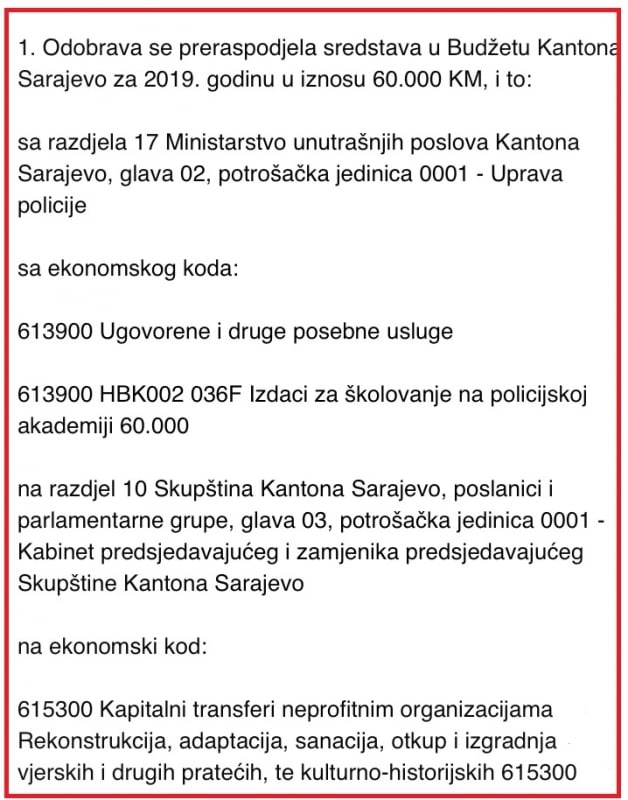
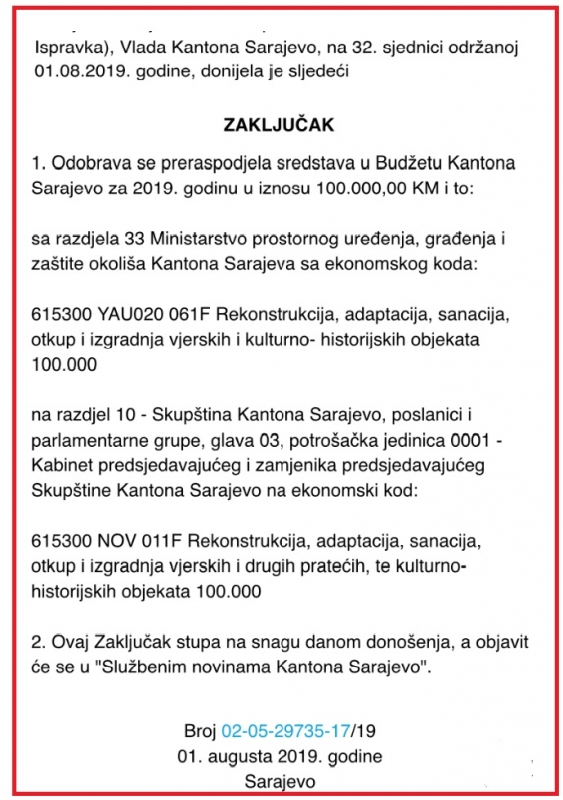
https://www.akta.ba/vijesti/konakovic-sest-miliona-km-za-nabavku-opreme-u-zdravstvu/82844?fbclid=IwAR0LIo9PyS7EbwV4ZCPAeqX9eM-pEtk89lD9WAG2x1ICfxw9Z08cBzjbS8M
Premijer Kantona Sarajevo, Elmedin Konaković poručio da satnica, koju traže štrajkači, nikako ne može iznositi 2,75 KM. Smatra da su se troškovi života u KS-u smanjivali, te da nije bilo zakonske obaveze da se usklađuje plata. Zdravstveni radnici Kantona Sarajevo su u štrajku od 13. oktobra. Trenutna satnica u KS za zdravstvene radnike je 2,31 KM, a rade 37,5 sati sedmično. Posljednje usklađivanje satnice je napravljeno 15. aprila 2008. godine..
(FENA)
Premijer Kantona Sarajevo Elmedin Konaković najavio je da će danas održati sastanak sa predstavnicima Sindikata radnika zdravstva KS-a kako bi usaglasili stavove oko okončanja štrajka.
Konaković je kazao za Fenu da je rebalansom budžeta, koji će se pred zastupnicima Skupštine KS-a naći krajem oktobra, previđeno da se šest miliona KM izdvoji za nabavku opreme, kako bi izdvojenih 15 miliona trošili na plaće.
Poručio je da satnica, koju traže štrajkači, nikako ne može iznositi 2,75 KM.
"Za 40 sati rada sedmično, to bi na mjesečnom nivou iznosilo povećanje od 40.560.000 KM, dok za 37,5 sati 29.650.000 KM i to su novci koje ova Vlada nema. Do izbora bi mogli isplaćivati te plate, ali bi sistem nakon toga krahirao", naglasio je Konaković.
Izrazio je želju da zdravstveni ranici imaju najbolje plate u regionu, jer su najbolji, ali da je nemoguće u godinu dana riješiti sve probleme koji se gomilaju u zdravstvu.
"Bio sam iznenađen činjenicom da imamo čak 15 miliona za povećanje plaća, ali to je bilo malo ili nedovoljno ljudima koji vode jedan od ovih sindikata i napravili su taj štrajk za koji mislim da ne donosi ništa dobro ni nama ni pacijentima", kazao je.
Dodao je da je predstavnike sindikata pozivao više puta da zajedno pregledaju prihode i rashode u zdravstvu, ali da još nisu postigli to.
"Komisije i visoke plate su završena priča, jer je Vlada KS-a to već stavila pod kontrolu i ne postoji ni jedan aktuelan razlog za štrajk", ocijenio je Konaković.
Smatra da su se troškovi života u KS-u smanjivali, te da nije bilo zakonske obaveze da se usklađuje plata, što štrajkači također prigovaraju.
https://ba.n1info.com/vijesti/a107980-konakovic-u-istanbulu-pokazali-ste-kako-se-brani-vlast/
Premijer Kantona Sarajevo Elmedin Konaković je u pratnji delegacije posjetio gradonačelnika Istanbula Kadira Topbasa te mu tom prilikom izrazio saučešće zbog žrtava tokom pružanja otpora pokušaju državnog udara FETO-a.
Konaković i Topbas su posjetili mjesto sa fotografijama i imenima poginulih tokom pokušaja državnog udara gdje su pritom položili cvijeće.
Konaković je tokom posjete istakao kako je sa zabrinutošću pratio dešavanja u noći pokušaja puča.
“Ovdje se nalazimo kako bismo odali počast braći koju smo izgubili, a koja je svojim postupcima cijelom svijetu pokazala kako se srčano brani Vlada i vlast izabrana demokratskim putem. Također, ovdje se nalazimo kako bismo poslali jasnu i snažnu poruku u ime svih građana Kantona Sarajevo i BiH. Sa zabrinutošću smo pratili dešavanja tokom ovog izdajničkog pokušaja u Turskoj. Zabrinutost se već narednog dana pretvorila u veoma snažan ponos. Osjećao sam se veoma ponosno zato što su lideri i narod Turske još jednom pokazali cijelom svijetu svoju snagu. Još jednom vam želimo čestitati na stavu u vezi s lekcijom iz demokratije koju ste dali cijelom svijetu”, kazao je Konaković.
Topbas se tokom susreta zahvalio premijeru Kantona Sarajevo na upriličenoj posjeti kao i cijelom narodu BiH.
“Događaj koji se desi u bilo kojoj zemlji utječe na cijeli svijet. Da su ovi izdajnici uspjeli u svome naumu, u svijetu su se mogli pojaviti mnogi problemi i nedaće. Dobro je da je naš narod odmah odgovorio na poziv predsjednika Turske i snagom vjere i iskrenih srca izašli na ulice. Cijelom svijetu su poručili da se protiv volje naroda i građana ništa ne može uraditi. Naš narod je umio stati pred tenkove i avione. Platili smo cijenu, ali ovi izdajnici nisu uspjeli ostvariti svoje ciljeve”, kazao je Topbas.
Na kraju je istakao kako se, nakon posljednjih događaja u Turskoj,
više nigdje u svijetu pučisti neće usuditi da zanemare snagu i volju
naroda.